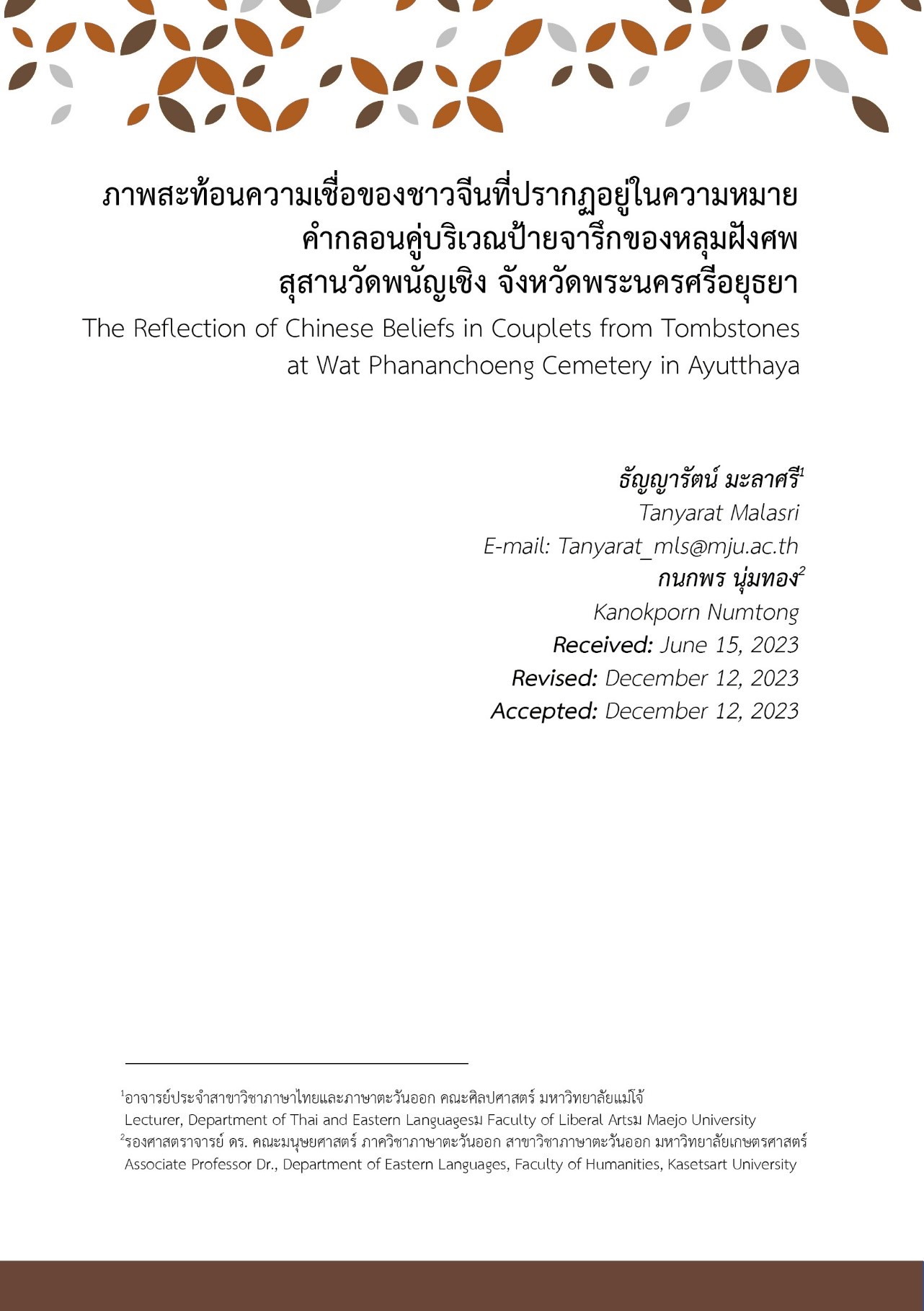The Reflection of Chinese Beliefs in Couplets from Tombstones at Wat Phananchoeng Cemetery in Ayutthaya. ภาพสะท้อนความเชื่อของชาวจีนที่ปรากฏอยู่ในความหมายคำกลอนคู่ บริเวณป้ายจารึกของหลุมฝังศพ สุสานวัดพนัญเชิง จังหวัดพระนครศรีอยุธยา
Main Article Content
Abstract
This research paper intends to study the reflection of Chinese beliefs through the couplets that appear on tombstones at Wat Phananchoeng cemetery in Ayutthaya. It studies 21 couplets from 595 tombstones and performs a content analysis of each one of them. We categorize them into 3 main categories, which are: 1. Couplets that reflect the main principles of feng shui, which are 8 out of the total 21 couplets (38.10%); 2. Couplets that reflect the honor of ancestors and families, which are 7 out of the total 21 couplets (33.33%); and 3. Couplets that reflect life after death, which are 6 out of the total 21 couplets (28.57%). These couplets also reflect different aspects of Chinese beliefs such as 1. Life after death according to the Confucian philosophy, Taoist philosophy, and Buddhism; 2. The reflection of the concept of living according to the natural principles of the Taoist philosophy, and 3. The principles and beliefs of feng shui. These couplets show that Thai-Chinese descendants in Thailand understand their cultural roots and beliefs as well as their relations to nature and society.
Downloads
Article Details

This work is licensed under a Creative Commons Attribution-NonCommercial-NoDerivatives 4.0 International License.
References
Chaiya, K. (2018). Chinese, shrines and vegetarian restaurants on the island of Phra Nakhon Si Ayutthaya. Journal of Ayutthaya Studies, 10(1), 1.
Chao Muang, C. (2021). The Chinese and their belief in the world after death (Bachelor's thesis). Silpakorn University, Nakhon Pathom.
Duan, L. & Rai Suksiri, B. (2000). History of Chinese temples and Chinese shrines in Thailand. Bangkok: Songsyam Publishing House.
Charoenvorakiet, S. & Sungrusa, N. (2015). Feng Shui: Beliefs, Knowledge, and Power of Management and creating social space. Veridian E- Journal, Silpakorn University, 9(2), 1720-1733.
Kasetsiri, C. (1999). History and politics. Bangkok: Toyota Thailand Foundation.
Kluenmonthon, D. (2016). How Chinese people after death. Retrieved January 13, 2023, from https://lek-prapai.org/home/view.php?id=905
Kongthaen, P. (2017). Funeral and burial traditions for Thai-Chinese people In Maha Sarakham Province. Proceedings of 13th International Conference on Humanities & Social Sciences 2017 (IC-HUSO 2017) 2nd-3rd November 2017, Faculty of Humanities and Social Sciences. Khon Kaen: Khon Kaen University.
Kotphuthon, K. & Chaitaweep, C. (2015). The study of the ethics of confucius. Academic Journal Bangkokthonburi University, 3(2), 12.
Li, X. (1997). New bronzeware research. Beijing: Cultural Relics Publishing House.
Patthranuprawat, R. (2008). Globalization and transformation of Chinese shrines in Samut Songkhram province. University of the Thai Chamber of Commerce Journal, 28(3), 79-105.
Prachit Pom Arin (2020). The concept of life and death in Chinese culture. Retrieved January 13, 2023, from https://www.arsomsiam.com
Prepremjao, S. (2014). Economic and social changes of Phra Nakhon Si Ayutthaya city island 1940-1991 (Master’s thesis). Silpakorn University, Nakhon Pathom.
Ruengruglikit, Ch. (2004). Early Ayutthaya literature: common characteristics and Influences. Bangkok: Academic Works Dissemination Project, Faculty of Arts, Chulalongkorn University.
Saen Buran, P. (2005). Mahayana buddhism. Bangkok: Odeonstro Publishing House.
Satjawatcharaphong, S., Thammawimon, P., Tochaiwat, K. & Chiwasuwan, A. (2014). Physical design guidelines for Ashes Collection Projects. In W. Honyangkul (Chair), Built Environment Research Associates Conference II. Symposium conducted at the meeting of the Faculty of Architecture and Planning. Pathumthani: Thammasat University.
Sinwiwattanakun, J. (2014). A study and analysis of the couplets on the pillar inscriptions of a Chinese cemetery. Case study: Huai Sei Cemetery, Mueang District, Ubon Ratchathani Province. (Independent Study). Ubon Ratchathani University, Ubon Ratchathani.
Supaporn, M. (2003). A study of reflections on couplets (Mo Huak Liang) in Mueang District Ratchaburi Province (Master’s thesis). Mahidol University, Nakhon Pathom.
Supathit, N., Boonkead, B. & Young Phet, B. (2017). Funeral rituals for Thai-Chinese people in Chonburi Province. Political journal Administration and Law, 8(1), 323-340.
Skinner, G. (2005). Chinese society in Thailand. Bangkok: Humanities and Social Sciences Textbook Project Foundation, Thammasat University.
Thammainlad, A., Panyapa, R., & Shu, H. (2021). Applying the concept of water in Taoism to life. Panithan Journal, 17(2), 152.
Thongkrajai, A. (2017). Communicating cultural meanings through rituals of Thai-Chinese people in Maha Sarakham Province. Proceedings of 13th International Conference on Humanities & Social Sciences 2017 (IC-HUSO 2017) 2nd-3rd November 2017, Faculty of Humanities and Social Sciences. Khon Kaen: Khon Kaen University.
Thongkamsamud, C. (2011). The scientific essence of Feng Shui beliefs. Academic Journal, Faculty of Architecture Khon Kaen University, 10(1), 1-10.
Wu, X. (2007). The life of Chinese philosophy (philosophy research). Tianjin: Nankai University.
Yang, B. (1980). The Analects of Confucius. Beijing: Zhonghua Book Press.
Yin, W. (2011). Analysis of moral reasons from burial to cremation in rural areas (Master’s thesis). Huan, Capital Normal University.
Yothinsirikun, S. (2018). Chinese auspiciousness and beliefs according to Feng Shui science of Thai-Chinese people in the Yaowarat community. Silpakorn University Journal, 38(5), 119-143.


